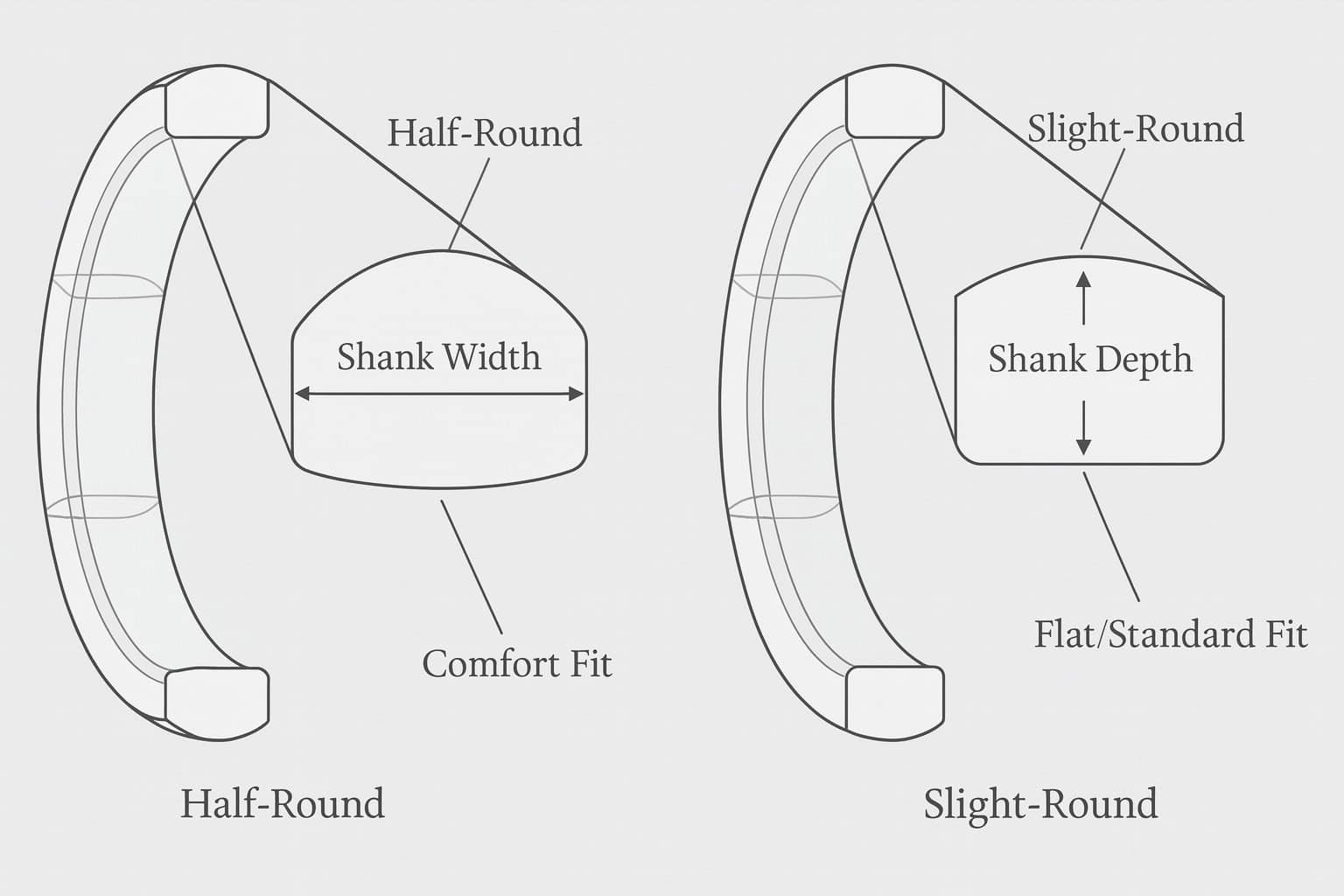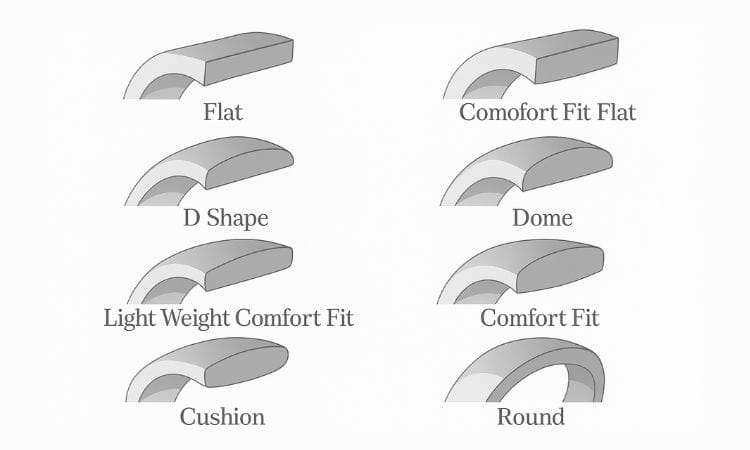Comprehensive Guide to Ring Profiles - Understand the Cross‑Section of Your Engagemnt Ring Band
When most people picture an engagement ring or wedding band, they think metal colour, stones and finish. But the hidden hero of comfort and style is the ring profile—the shape you’d see if you sliced the band and looked at its cross-section. The profile influences how the ring feels day-to-day, how it stacks with an engagement ring, and even how durable the edges are over time.
Why ring profile matters
- Comfort & fit: A curved interior (often called “comfort fit” or “court”) glides over the knuckle and reduces pressure during wear.
- Look & presence: The outer shape changes how bold or minimal a band appears.
- Practicality: Rounded edges are kinder to clothes and skin; sharper edges can look sleek but may catch.
- Stacking: Flat sides or edges help bands sit flush with engagement rings or other bands.
The main profiles (with pros and cons)
Flat (Pipe-Cut)
Cross-section: Flat inside and outside with squared edges.
Why choose it: Modern, minimal, architectural look; sits low under many settings.
Keep in mind: Squared edges can feel “boxy” to some; edges may show wear sooner if highly polished.
Comfort Fit / Court
Cross-section: Curved inside; gently domed outside.
Why choose it: All-day comfort; glides on/off easily; classic look that suits most widths.
Keep in mind: Slightly more metal than a standard flat interior for the same outer dimensions.
Flat Court (Comfort Flat)
Cross-section: Flat outside with a curved (comfort) interior.
Why choose it: Modern flat look with comfortable inner curve; stacks neatly with straight-sided rings.
Keep in mind: Outer edges remain defined; consider a light bevel if you’re snag-sensitive.
D-Shape (Standard Fit Outside, Flat Inside)
Cross-section: Domed outer surface; flat inner surface.
Why choose it: Traditional profile with vintage character; low dome complements slim widths.
Keep in mind: Flat inner surface can feel snug on wider bands; moisture can sit between band and skin for some wearers.
Rounded Court / “Heavy Dome”
Cross-section: More pronounced dome outside; curved inside.
Why choose it: Bold, classic presence; great for wider bands and heritage aesthetics.
Keep in mind: Sits taller; if you prefer low-profile, choose a lighter dome.
Cushion Court / Double Comfort
Cross-section: Rounded inside and outside with softened or slightly flat edges.
Why choose it: Super comfortable; edges soften the look and help stacking without biting the neighbouring ring.
Keep in mind: Appears a touch wider due to edge rounding—check proportions if pairing with a very delicate engagement ring.
Knife-Edge
Cross-section: Two slanted planes meeting at a central ridge on top; interior can be comfort fit.
Why choose it: Crisp, sculptural look that catches light beautifully; pairs well with solitaire settings.
Keep in mind: Ridge can feel more prominent; micro-rounding the ridge improves comfort.
Bevelled Edge
Cross-section: Flat or gently curved top with angled facets along the edges; interior varies.
Why choose it: Contemporary detail; angles reduce the “boxy” feel while keeping a modern silhouette.
Keep in mind: Facets show scratches differently; matte finishes can minimise this.
Concave
Cross-section: Outer surface dips inward (a shallow “valley”); interior can be comfort fit.
Why choose it: Distinctive, sleek profile with striking light play; looks great with matte finishes.
Keep in mind: Requires precise finishing to avoid sharp edges; typically suits medium widths and above.
How to choose the right profile
1) Comfort first
- If you’re new to wearing a ring or have larger knuckles, a comfort-fit interior (court) is often the safest choice.
- Sensitive to edges? Choose court, cushion court, or rounded court. Ask for lightly softened edges on flat designs.
2) Match your lifestyle
- Hands-on work: Favour rounded profiles and brushed finishes to disguise wear.
- Office/light wear: Flat, bevelled or knife-edge profiles offer crisp style without heavy wear.
3) Consider stacking
- Pairing with an engagement ring: Flat or flat-court sits flush and reduces gaps.
- Two or more bands: Cushion court or lightly bevelled edges help avoid “biting” between rings.
4) Proportion and width
- Slim fingers or delicate engagement rings: Lighter domes (classic or D-shape) in 1.8–2.2 mm thickness keep things refined.
- Broader fingers or a stand-alone band: Rounded court or bevelled edge in 2.2–2.5 mm thickness gives presence without bulk.
5) Finish smart
- Polished shows every scratch; matte, satin or brushed finishes are forgiving.
- On flat and bevelled profiles, alternating finishes (e.g., matte top, polished bevel) pops the geometry.
Quick selector
- Max comfort, timeless: Comfort Fit / Court, Cushion Court
- Modern, stacks well: Flat Court, Bevelled Edge
- Traditional classic: D-Shape, Classic (light dome)
- Sculptural statement: Knife-Edge, Concave
- Work-friendly: Rounded edges, brushed finish, medium thickness
Brilliyond recommendations
- Everyday comfort: Comfort Fit (court) at a sensible thickness for your width.
- Flush stacking with engagement rings: Flat Court with softened edges.
- Bold, modern look: Bevelled or Knife-Edge with a brushed top.
- Unique texture play: Concave with a matte exterior.
Final tip
Bring your engagement ring (if stacking) and try profile samples in your true width. A five-minute fit test tells you more than photos ever can.








Comments (0)
Write your review